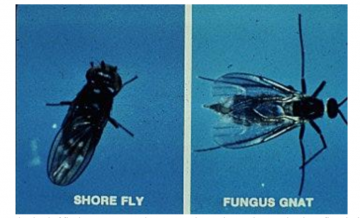Help! There are tiny little black flies that keep buzzing around my houseplants. I’ve noticed them crawling around in the soil and on the pots. Are they hurting my plants?
Sounds like you might have a case of fungus gnats, reader. Fungus gnats are flies(from a bunch of different species) that live in your soil, feeding on algae, fungus (duh), and dead things in your soil.
The good news: they don’t bite or sting and they’ll actually help things in your soil decompose. The bad news: they’re only mostly harmless, as fungus gnat larvae can damage your plants. The larvae like to feed on algae and fungus, but they also don’t have any problem with taking a bite out of plant roots. If there are enough of them, they can damage or even kill your plants. Even worse, both larvae and adults can spread root diseases.
Don’t panic. First, let’s figure out if you really do have fungus gnats. Are your flies long and leggy, or kind of round and chubby? Do they like to run around and hide, or do they like to buzz around in your face?

The other kind of fly that enjoys spending time with your houseplants is the shore fly, which looks a lot like a fungus gnat, but is completely harmless. Shore flies are much rounder than fungus gnats and are strong fliers, whereas our fungus gnat friends are terrible fliers, but would do great in a marathon. If you have shore flies, your plants are in no danger, but they’re still probably really irritating. So what can you do about these unwelcome visitors? Before you consider breaking out a can of bug spray, try these gentler solutions first.
- Fungus gnats (and shore flies) really enjoy wet soil. If you have fungus gnats, it probably means you’ve been watering too much. Try cutting back on the watering and letting your soil dry out.
- Do you add compost to your houseplants? That might be an issue. Wet, decomposing organic matter is heaven to fungus gnats. Cover up your soil with some sand, gravel, or just swap out that compost with some potting mix.
- Try trapping those larvae! Larvae (like me) really enjoy potatoes. Cut up a potato into tiny cubes and put them into the soil. The larvae will burrow into the potato cubes as they eat. To get rid of them, just take the cubes out after a few days and (carefully) throw them away into a sealed plastic bag. Repeat as necessary.
No luck with those solutions? Wait a few weeks. Unfortunately, fungus gnats take 2 weeks to grow up from egg to adult and they live for about a week as an adult, so you won’t see any results from your work for least 3 weeks.
Still no luck? There are a few insecticides that you can use. I’m not going to recommend any synthetic insecticides (inside your house?!?!) but there are few organic options that you can find in gardening centers. Use these carefully, responsibly, and only if you have to.
- Gnatrol is really effective against gnat larvae. This organic insecticide is actually derived from a bacteria (Bacillus thurengiensis, or Bt) and comes in a powdered form that you mix with water. Find this stuff online or check a few different gardening stores.
- Insecticidal soap is, just that, soap which happens to be insecticidal. They tend to come in sprays, so you can just spray-drench the surface of the soil. You can find different kinds of soaps in gardening stores. Just be careful with this one, too much will kill your plants! Follow the directions on the label.
- You might also find some organic insecticides that use something called pyrethrins. These are chemicals extracted from a certain kinds of chrysanthemum flowers that are very insecticidal. They will work really well and are fairly safe for people to handle.
You might also find some botanical solutions effective, but they’re a little trickier and can damage your plant. There are certain plant oils like neem oil or tea tree oil which are very insecticidal, but can also damage your plants. The internet also recommends solutions like sprinkling ground cinnamon into your soil, which relies on the killing power of cinnamon essential oil, but you’ll get mixed results based on how fresh your cinnamon powder is and how much you add in. You’re on your own if you’d like to try this.
I hope this answered your question, reader. Flies are an annoying problem, but a good gardener has a solution for everything.
Until next time, happy gardening!